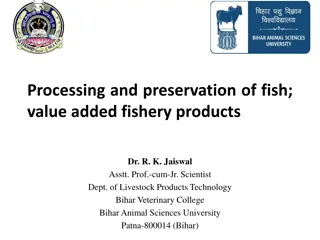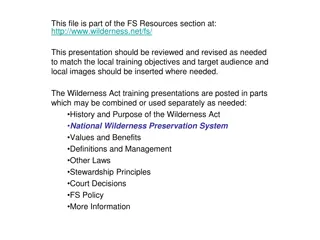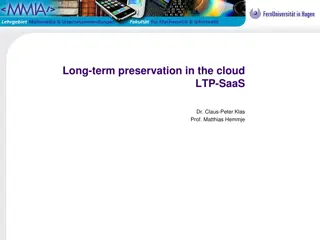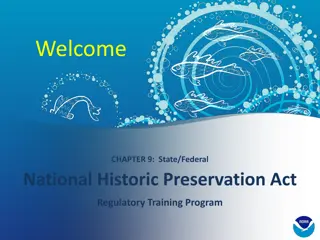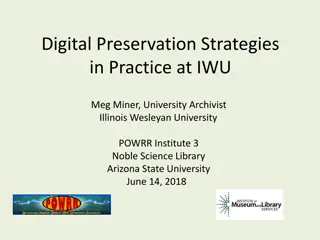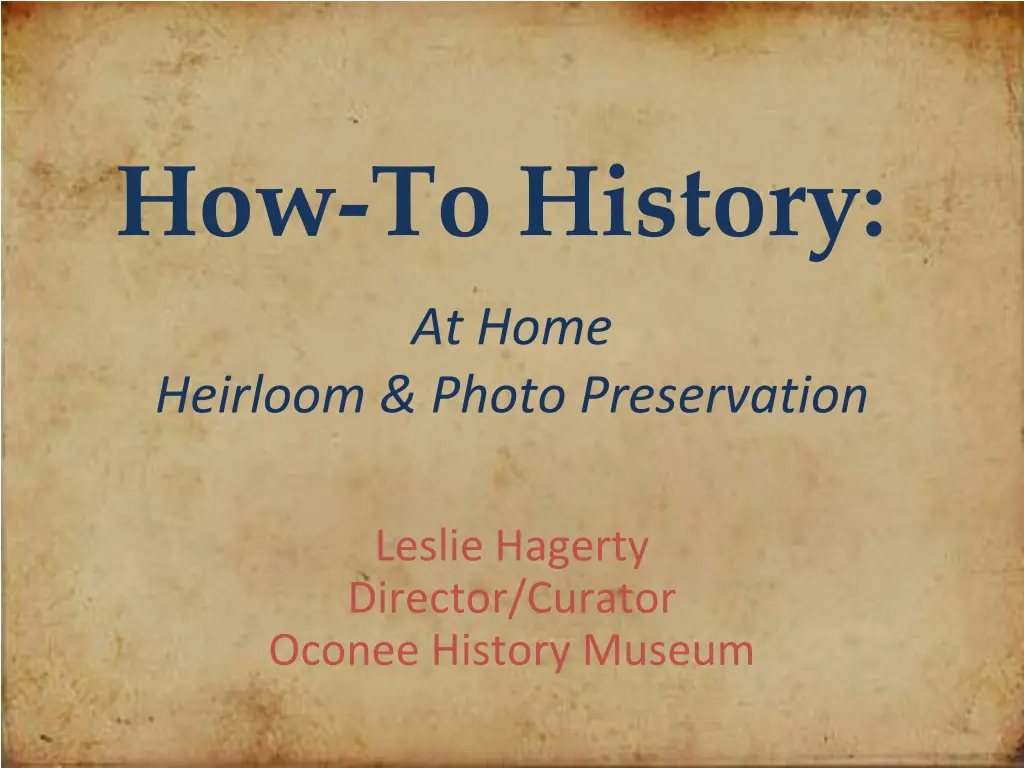
Home Heirloom & Photo Preservation: Expert Tips & Techniques
Learn essential strategies for preserving heirlooms and photos at home, including determining historic value, common materials, care factors, vocabulary, storage options, display ideas, and proper labeling techniques.
Download Presentation

Please find below an Image/Link to download the presentation.
The content on the website is provided AS IS for your information and personal use only. It may not be sold, licensed, or shared on other websites without obtaining consent from the author. If you encounter any issues during the download, it is possible that the publisher has removed the file from their server.
You are allowed to download the files provided on this website for personal or commercial use, subject to the condition that they are used lawfully. All files are the property of their respective owners.
The content on the website is provided AS IS for your information and personal use only. It may not be sold, licensed, or shared on other websites without obtaining consent from the author.
E N D
Presentation Transcript
How-To History: At Home Heirloom & Photo Preservation Leslie Hagerty Director/Curator Oconee History Museum
Determining Historic Value Factors to consider when evaluating an item: How old is it? Who used it? Is it rare or unique? Does it have sentimental value? Does it tell or illustrate a story? Is it in good condition? Do you have space to store or display it properly? Can you afford the care required?
Common Materials Paper & books Photographic prints, negatives & film Textiles & Leather Metal & Wood Ceramics & Glass Fine Art Plastics & Rubber Vinyl Records & Cassettes Digital media
Care Factors Different materials have unique needs for preservation & care: Handling Gloves or no gloves? To fold or unfold? Best way to label? How to repair damage? Storage or display environments Incorrect temperature, humidity, & light levels can cause damage and deterioration Hanging, folding, or lack of physical support can cause damage over time. Acidic cardboard boxes & framing materials can leach acid that accelerate deterioration.
Vocabulary Archival-quality Of the caliber used in professional preservation Acid-free Neutral pH Buffered A material with added alkaline to neutralize acid Lignin-free Lignin occurs in plants/trees that can produce acid Relative Humidity Humidity percentage relative to temperature Interleaving The act of placing protective material between items to prevent damage Preservation v. Restoration Preservation keeps the item from deteriorating any further. Restoration seeks to repair and reverse deterioration.
Storage & Display Options Boxes Metal edge, flip-top, clamshell, record, etc Folders Plastic sleeves Roll storage Furniture (cabinets, drawers, etc ) Display cases (curio cabinets, shelves, etc ) Frames & shadowboxes
Labeling Items - DO NOT DO NOT use sticky notes (will discolor & stain) DO NOT use pens or markers directly on items (will bleed & stain) DO NOT use adhesives directly on items (will damage & stain) DO NOT fasten labels (staples, nails, pins) DO NOT deface the item (be discreet)
Labeling Items - DO DO as little harm as possible DO use pencil DO place label in discreet location DO use acid-free paper tags tie on or minimally pin DO write clearly DO use A&B system for items that have separate parts (container & lid, cup & saucer) Consider adding more information in the container
Paper Handling Gloves? No - gloves reduce dexterity needed for brittle & fragile paper Avoid re-folding or re-rolling Storage & Display FLAT! Unfold or unroll, if safe DO NOT LAMINATE Remove unnecessary/dissimilar/damaging materials Paper clips, staples, sticky notes, rubber bands, etc Place in acid-free folders Interleave acid-free paper between pages, especially newsprint OR use acid-free plastic sleeves for single pages Avoid tape for repairs if necessary use acid-free Place in archival box or flat drawer Store or display in cool and dry environments to avoid rumpling or mildew Display in archival-quality frame (UV-proof glass & acid-free mats/backing) away from direct sunlight.
Books Handling Gloves? Yes and No Use white gloves when handling the outside of a book (especially if cover has fabric or leather). Use a bone folder or your ungloved finger tips to turn pages. When opening, support properly so that spine does not crack. Storage & Display Shelve books in a closed glass case away from light and damp areas Place similar sized books next to each other vertically, packing neither too loosely or tightly (avoid slumping and too much compression) Remove unnecessary objects (Paper clips, rubber bands, bookmarks) If book is too delicate for shelf storage, place flat in an acid-free box Store in cool and dry location to avoid mildew If displaying open, provide proper support to spine, avoid direct sunlight
Photographic Prints Handling Gloves? YES - prevents smudging & damage Handle by edges Storage & Display Store individually in an acid-free, adhesive-free paper envelope or a chemically-stable plastic sleeve OR Interleave photos with acid-free paper to prevent damaging contact Do not overly compress photographic prints to prevent image transfer Remove unnecessary materials Paper clips, staples, sticky notes, rubber bands, etc... Place envelopes/sleeves/folders in box or flat drawer Store in cool and dry environment to avoid curling Display in archival-quality frame (UV-proof glass & acid-free mats/backing) away from direct sunlight.
Photo Negatives & Film Handling Gloves? YES - prevents smudging & damage Handle by edges Storage & Display Store individually in an acid-free, adhesive-free paper envelope and/or a chemically-stable plastic sleeves Do not stack or overly compress photographic prints to prevent image transfer and scratching Store in cold storage (not practical for most at home) Immediately dispose nitrate film (contact Hazmat) Nitrate film produced up until 1950s can unpredictably combust ~100F and cannot be put out Digitize film & negatives as soon as possible. Vinegar smell signals deterioration
Textiles & Leather Handling White gloves? YES - oils from hands will stain textiles Make sure all preparation surfaces are clean DO NOT wash extremely delicate items Newer items can be washed or spot treated with Orvus WA Paste DO NOT use soap since it causes yellowing Storage & Display Store flat in unbuffered archival box (roll or loosely fold) Remove unnecessary materials (Pins, hangers, clips) Store in cool and dry environment to prevent mildew. Monitor for pest damage. Avoid long-term hanging as weight can cause damage. Periodically refold to avoid creasing that could eventually tear. Display away from direct sunlight to avoid fading & deterioration.
Metal & Wood Handling Gloves? YES - oils from hands will stain metal & wood Use care to prevent dents and scratches. Use gentle cleaning methods & always fully dry Storage & Display Place items in acid-free box with chemically inert padding Silver can be stored with silver cloth to deter tarnishing Reduce exposure to pollutants & reactants. Avoid exposure to humidity to prevent metal from rusting. Wood is extremely sensitive to temperature & humidity changes (warping, cracking, splintering, rot, etc ) Provide adequate support for display to prevent dents.
Ceramics/Glass Handling Gloves? YES - oils from hands will smudge Carry in a padded vessel Support by base, not handles, lips or edges. Use the most gentle cleaning methods, avoiding harsh chemicals Storage & Display Display on a level surface, protected from bumps & falls. Store in a padded archival box with acid-free padding and acid-free tissue. Protect lids or other removable parts separately
Fine Art Handling Gloves? YES - oils from hands will transfer & discolor work Lightly dust every few months. Use professional art conservator for professional cleaning. Storage & Display Display & store away from sunlight & temperature changes Make sure art is fully supported on wall or shelf. Mixed media poses unique challenges.
Plastic & Rubber Handling Gloves? YES - protects you from chemicals Can be extremely brittle Storage & Display Store in cool and dry space away from UV light. Be wary of off-gassing while in storage. May need oxygen-free storage (sealed bags).
Vinyl Records & Cassettes Handling Gloves? YES for records Dust gently with anti-static cloth Storage Store records & cassettes vertically Replace interior record sleeves with acid-free sleeves Place cardboard exterior sleeve in plastic sleeve Digitize as soon as possible Cassettes - store in cool, dry place to avoid mildew
Digital Media Handling Gloves? YES for CDs. Use caution when transferring files. Storage Store CDs in archival quality cases or sleeves and keep vertical to prevent scratching. Always have multiple backups. Be wary of format obsolescence (copy then convert!)
When Disaster Strikes Have an Inventory Make sure you have a full inventory with pictures and item locations in your home for insurance purposes. If damages occur, don t panic! Properly storing your items can help alleviate some damage by natural disasters. There are many conservators throughout the country that could help with damages Prevention Tips Store items at least 6 inches above floor level in case of flooding. Let wet items naturally dry (position to increase air flow). If storing anything in a safe or lockbox monitor periodically for mold.
Preservation Resources Archival Supply Companies Gaylord www.gaylord.com Archival Methods www.archivalmethods.com Hollinger www.hollingermetaledge.com University Products www.universityproducts.com Scrapbooking & fine art supplies are often archival quality (check labels)
Digitization What is digitization? Converting physical formats to digital formats Why digitize? Digitization is another layer of preservation and increases opportunities to access & share Creates access while minimizing the damage caused by frequent handling.
Digitization Methods Scan documents, photos, negatives Digitally photograph or video objects Digitally convert cassettes, films, & vinyl Convert digital media formats to prevent obsolescence
Preparing to Digitize Determine your priorities Consider: urgency, condition, access, value Determine your budget & ability Scope of project Access to equipment Time commitment DIY or hire professional?
Scanning Scanner types Flat-bed Sheet-fed Overhead Wand/Handheld Pros: portable Cons: not the highest quality Negative film scanner Pros: scans negatives Cons: only scans negatives (may not scan all sizes) Large-format Pros: scans large documents Cons: usually sheet fed & could damage if jams, EXPENSIVE Pros: easy & safe, scans photos, documents, & negatives Cons: bed size limitations Pros: allows for high volume of loose, durable, standard paper Cons: could damage document if it jams Pros: great for books Cons: hard to adjust lighting
You Scan Do It! Scanning tips Properly handle/clean material to scan Keep scanner surfaces clean For photos: JPEG is more useful, but TIFF is the archival standard For documents: save as PDF Keep an original and only edit copies Resolution: 400-800 DPI Use consistent, descriptive labels Keep your files organized CREATE REGULAR BACK UPS
Tips for Negatives Determine the right side of the image (glossy side) To scan negatives you need light from both top and bottom. Some scanners have settings for negatives & will automatically create a positive image. Scanner hack for negatives: place negative on scanner bed & use lightpad over it. Invert the image in MS Paint.
Photographing/Videoing Objects Clean & prepare the object. Set up a blank background & good lighting. Place a standard size reference item next to the object for scale (a ruler, a quarter, etc ) Take photos/video of all sides & zoom in on details Organize & label photos/videos
Professional Digital Conversion Submit your items to a company for conversion (in person or by mail) Receive a full cost estimate from the company Receive your choice of digital formats Receive your original items back Reputable companies: LegacyBox iMemories Watch for sales
DIY Digital A/V Conversion TEST PLAYBACK EQUIPMENT FIRST! Playback equipment you may need: VCR (for VHS tapes) VHS adapters (for mini DV or small tapes) Camcorder (VHS or mini DV) Turntable (for vinyl records) Tape deck (for cassette tapes) Direct conversion equipment: Video capture USB RCA cables (yellow, white, red) S-cable Indirect capture for conversion is better than nothing
Digitization Next Steps Consider transcribing documents or recordings Younger generations cannot read cursive writing. Documents may become illegible over time. Elderly voices, accents, or language barriers may pose problems for future listeners.
Digitization Resources National Archives - Digitizing Family Papers & Photographs 16 Digitization Tips








